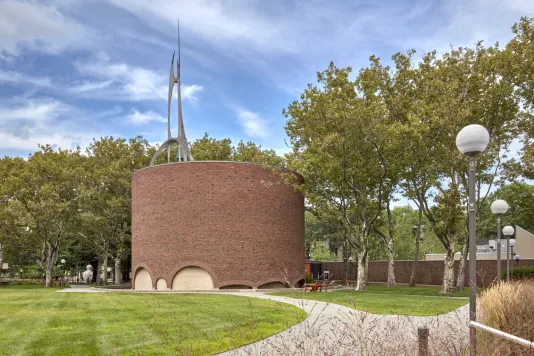Theodore Roszak, Bell Tower, 1955. Commissioned for Eero Saarinen Chapel MIT. Photo: Chuck Mayer Photography
Bell Tower for MIT Chapel, 1953

Theodore Roszak’s sculptures and prints bear the influence of Surrealism, Dada, and Constructivism, but his forms and materials were equally inspired by the events of his time.
In the late 1930s, Roszak began teaching at László Maholy-Nagy’s experimental Design Laboratory and fabricating painted wood, metal, and plastic constructions based on Bauhaus and Constructivist ideas. These distinctive freestanding works, ranging from two to nine feet in height, juxtaposed abstract geometric shapes in primary colors with a strong industrial aesthetic. While designing aircraft for a corporation in New Jersey during World War II, Roszak became disillusioned with the violent use of technology, and abandoned his machinic constructions in favor of expressionistic welded-steel sculptures. He also produced many large-scale drawings of cosmological subjects.
Several years later, Roszak was commissioned to collaborate with sculptor Harry Bertoia and architect Eero Saarinen to design a spire and bell tower for Saarinen’s non-denominational Chapel at MIT. The bell, also designed by Roszak, was cast at the MIT foundry, and the assembly was installed in 1956. Roszak’s first major architectural commission, Bell Tower provides a fittingly imaginative pinnacle to the building. Its soaring design with three spires of varying heights evokes forms suggesting both a dome and a cross. The tower also references the cosmos in a secular sense: the sleek forms and unusual material choice of aluminum were likely inspired by the design and technology of the space age. The bell itself hangs at the base, as if an engine ready to power the elegantly poised frame. But any sense of violence is undercut by the tower’s slight, hollow build and tapering forms. Just a year after the tower’s installation, the Soviet Union launched Sputnik, spurring the United States to create the National Aeronautics and Space Administration (NASA).
Theodore Roszak (1907–1981) was born in Poznań, Prussia (now Poland) and immigrated to the United States with his family at the age of two. He began his studies at the Art Institute of Chicago, taking evening classes while attending high school and enrolling as a full-time student in 1925. Drawn to New York by the American Realist painters, Roszak left Chicago in 1926 to study at the National Academy of Design. He also took private lessons with George Luks while attending courses in logic and philosophy at Columbia University. In 1927, he moved back to Chicago and soon began teaching at the Art Institute. Granted a European travel fellowship, Roszak spent the next few years in Prague and visited Paris as well as other European cities, assimilating the major currents of European Modernism. After settling in New York, he found success as a sculptor while working as a professor of art and, at one point, of aircraft mechanics.
Roszak’s many awards and fellowships include a Tiffany Foundation Fellowship (1931), a Frank G. Logan Medal from the Art Institute of Chicago (1930), and a George D. Widener Memorial Gold Medal (1956). His numerous group and solo exhibitions have taken place at the Whitney Museum of American Art, New York; Art Institute of Chicago; Addison Gallery of American Art, Andover, Massachusetts; Museum of Modern Art, New York; Tate Gallery, London; Walker Art Center, Minneapolis; and Rodin Museum, Paris. Roszak died in New York in 1981.